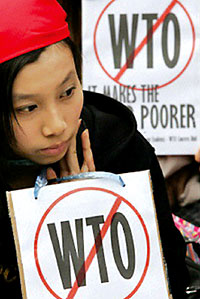 Akilo of low quality rice today sells for Rs 20 in Nepal. Given that most Nepali households eat rice at least once a day, one would think that a drop in the price of rice should make people happy. Wrong.
Akilo of low quality rice today sells for Rs 20 in Nepal. Given that most Nepali households eat rice at least once a day, one would think that a drop in the price of rice should make people happy. Wrong. If there is a sudden influx of rice priced at Rs 15 a kilo into the Nepali market, the effect will be devastating, both in social and economic terms. Securing the right to protect Nepal's domestic rice market and farmers who depend on its production is the main goal of Nepal's delegation at the sixth WTO Ministerial Meeting in Hong Kong.
"Since 77 percent of Nepalis are farmers, a fall in the price of crops will also mean a huge drop in earnings for many families," says Posh Raj Pandey, who heads the Trade Related Capacity Building project supported by UNDP. "A lower price will only benefit the people not living off the rice fields and those people tend to be better off and living in Kathmandu. We need to be able to aggressively expand our exports and still protect our farmers."
Such policy flexibility, or 'special safeguard measures' as it is called in WTO-speak, was already written into the draft text of the agreement prior to this meeting. It's been agreed that if imports exceed a certain threshold level, a nation belonging to the group of Least Developed Countries (LDCs) such as Nepal, will be allowed to raise tariffs or even ban imports or define quotas. What has not yet been agreed is the actual level of the threshold.
Negotiations are a question of give and take and in Hong Kong they are about the right to be defensive and protective, and aggressive and expansionistic at the same time. Basically, boosting exports while still protecting domestic markets is also what the other 149 WTO member states want but it is the size of domestic agricultural support that is the real hot potato here.
Currently it is accepted that LDCs can support domestic agriculture by spending as much as the equivalent of 10 percent of their GDP on subsidies. However, Nepal's current level of subsidies amounts to only 1-2 percent.
"On paper it could look as if Nepal should aim at getting everyone else down to our level but if we look at the future potential of the country, we might want to give more and therefore it will be important for Nepal to maintain some flexibility here and not agree on a low level of support," says Navin Dahal of the Kathmandu-based South Asia Watch on Trade, Economics & Environment (SAWTEE).
Nepal is participating in the WTO talks as a full member for the first time, following its accession in 2003. However, it is not negotiating on its own but as one of the LDC group, which is seeking a drastic reduction in agriculture and export subsidies provided by the EU and US.
Nepal's main exports are textiles, leather goods, carpets, handicrafts and tea but volume will have to grow to push economic growth. "Expanding market access for the products
that we already make is important," says Gyan Chandra Acharya, Nepal's ambassador to the WTO. Nepal and other LDCs need better market access for exports, including more countries agreeing to give products special tariff treatment or 'differential treatment', Acharya adds.
The two previous WTO meetings in Seattle and Cancun collapsed and although this one is billed as critical for completing a new multilateral trade accord, Nepal's delegation is acutely aware of the competing interests.
Says Dahal: "In Doha it was decided that the LDCs should have better market access and long-term periods of transition... However, almost all these nice commitments are not mandatory and I find it hard to believe that the WTO members can agree on more binding measures."


